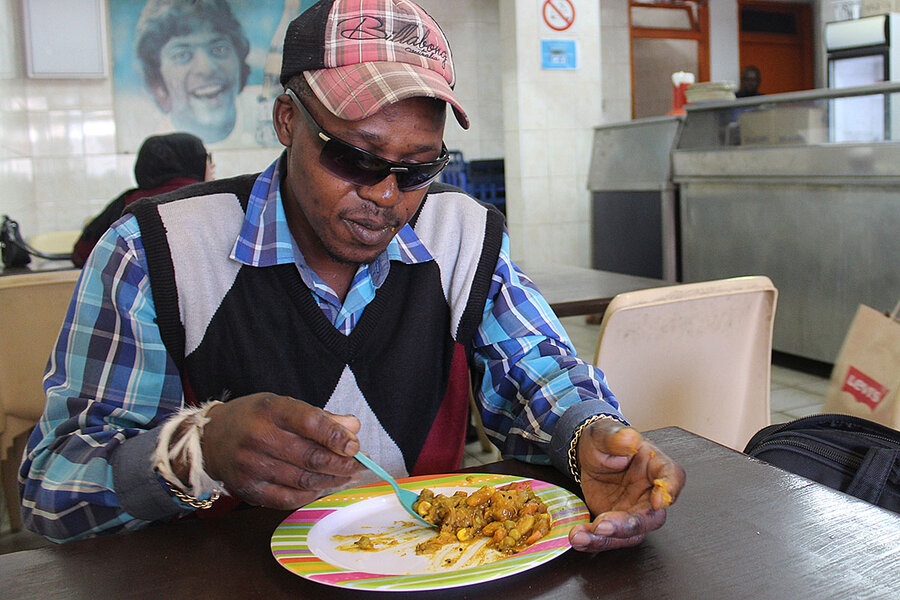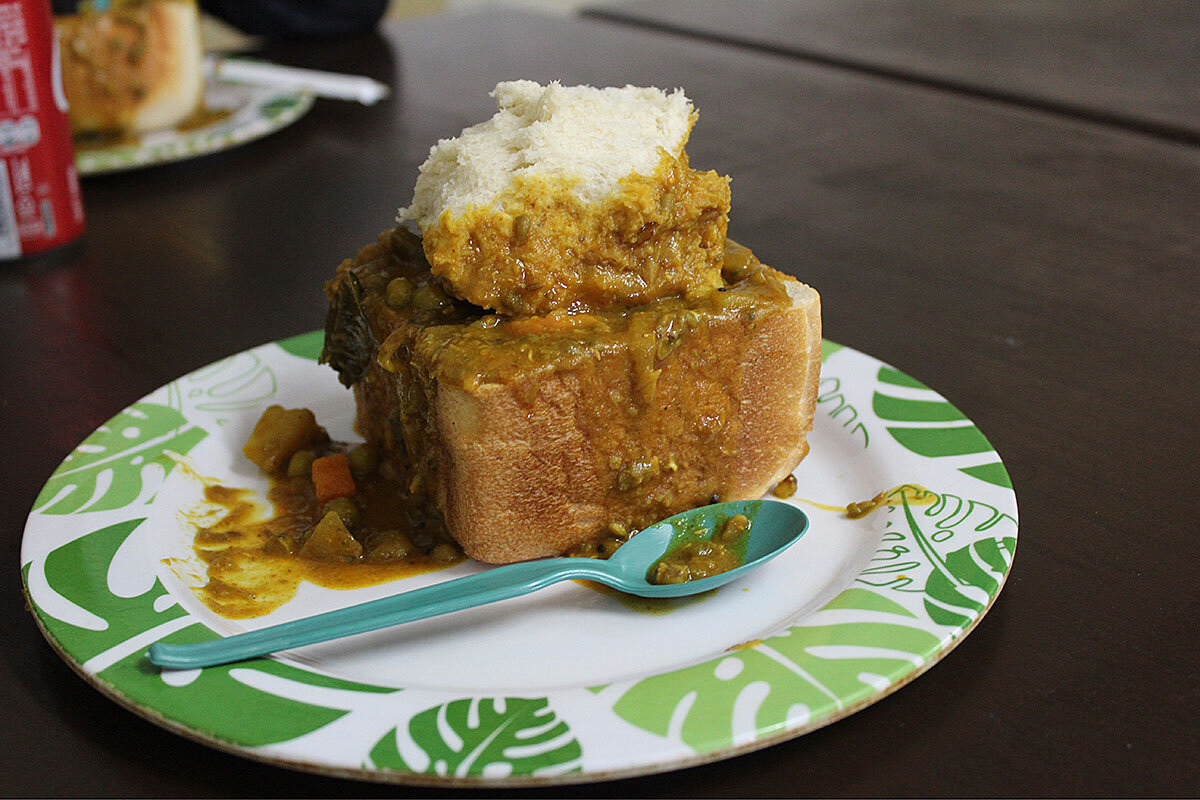Bunny chow: South African history in a loaf of bread
Loading...
| Durban, South Africa
There are a few must-dos for any first-time visitor to Durban, a city of rolling hills in eastern South Africa. Among them: You must be sure to have a bunny.
Wait, a what?
Actually, bunny is short for bunny chow – but don’t be fooled. It’s not a rabbit, or a rabbit’s food. The Durban bunny chow is actually a hollowed-out loaf of bread filled with spicy curry, and it’s this city’s star culinary attraction.
Why We Wrote This
When someone invites you to have a bunny in South Africa, don’t be alarmed. “Bunny chow” is one of the country’s iconic foods. And inside that loaf of bread is more than a grab-and-go meal – it’s a lunch-sized history lesson.
“A bunny chow is to Durban what a pizza is to New York,” says Ritesh Patel, part of the third generation at Patel’s Vegetarian Refreshment Room, a takeout joint that is one of Durban’s earliest bunny chow peddlers. “It’s that standard comfort food for this place. The food of the people.”
It’s also a meal that was forged at society’s margins – a riff on Indian cuisine that is both a tribute to South Africa’s dizzying diversity and a reminder of its violent origins.
There are many legends of the bunny chow’s illustrious beginnings, but they all share a few common features. For one thing, it’s undoubtedly the creation of Durban’s Indian community, most of which arrived here as 19th century indentured laborers, shipped in by the British to work the sugar-cane plantations and railroads.
It also probably owes its name to the banias, the city’s early Indian shopkeepers. By the early 20th century, several were running lunch counters. And then one day, the legend goes, one of them had a novel idea: hollow out a loaf of bread and fill it with beans curry. Voilà: a kind of low-budget, edible lunch pail for workers at the nearby factories and shops.
“The story is basically that some guys invented a lunchbox made of bread, and the rest is history,” says Vishaal Sewpersadh, who works in IT in Johannesburg but makes a pilgrimage to his favorite bunny chow joints whenever he comes into town to visit family.
Some versions of the lore, however, offer a darker reason. In early 20th-century South Africa, people of different skin colors often couldn’t share the same shops, the same neighborhoods, and certainly not the same restaurants. Enter the bania chow, a takeout meal that black customers could eat on the road.
Whatever its precise origins, bania chow morphed into bunny chow. Joints selling the curry bread bowls proliferated along the length of the Grey Street Casbah, a multiracial stretch of shops, mosques, and apartment blocks through the center of Durban’s downtown.
(Around the same time, cousins of the bunny chow were born as laborers’ food in other major cities as well. Johannesburg got the “kota” – tectonic layers of cheese, bologna, french fries, and fried eggs balanced between the four walls of a hollowed-out quarter loaf of bread. And Cape Town’s answer was the Gatsby, a glorious riff on the British chip butty – a sandwich stuffed to bursting with fries, meat, cheese, and chutneys.)
Like many pockets of multiculturalism in South Africa, the Grey Street Casbah was known for its music (jazz), its gangsters (feared), and its politics (anti-establishment). In the earliest years of Patel’s Vegetarian Refreshment Room, the restaurant shared a road with the offices of a fiery young Indian lawyer who’d gotten into politics after being kicked off the white section of a local train.
His name? Mohandas Karamchand Gandhi.
Did Gandhi ever drop in for one of the Patels’ famous beans bunnies, the turmeric so thick that it stained your hands deep yellow? (The first rule of bunny chow, after all, is that you must eat it with your hands.)
That much is lost to the ages, but when it comes to South African history, the Patels have seen a great deal.
From the windows of their small shopfront, and the apartment they built above it, family members watched as the apartheid government began to move out black, mixed-race, and Indian residents of the area, scattering them to segregated neighborhoods on the fringes of the city. A few Indian families, like theirs, were allowed to stay, but their neighborhood was eventually whittled down to just a few square blocks.
When apartheid ended in the 1990s, South Africa’s cities became the site of another radical transformation, morphing into hubs for migrants from around the country and across the continent.
Today, Grey Street is Dr. Yusuf Dadoo Street, renamed for an Indian titan of the anti-apartheid movement. Zulu gospel music jostles for space with calls to prayer from the gold-domed Juma Mosque down the road. Hawkers sell fat green avocados, roasted corn on the cob, and 25 kinds of knockoff brand name shoes, while prospective customers stream by chatting in Zulu, Shona, and Lingala.
Most of the original bunny chow shops have shut down or relocated to the slick suburban malls. At Patel’s, too, business is down. But Mr. Patel’s father, Manilal, 77, still rises each morning at 1:30 a.m., as he has for the last 65 years, to begin cooking his cavernous vats of curry. The standard-sized bowl – perhaps four thick slices of bread deep – sells for 15 rand (about $1), and the shop will sell about 800 in a day.
But the younger Mr. Patel doesn’t know how much longer the store will survive here. Both his grandfather – whose portrait smiles down over his onetime lunch counter – and his father came of age at a time when opportunities for brown men like them had a hard, low ceiling. Neither had a chance to finish school.
Mr. Patel and his siblings, on the other hand, grew up as racial barriers toppled around them. He and his brother are accountants; his sisters are pharmacists. But there is still a part of him most at home in the Casbah, where he once sweet-talked neighboring shop owners into giving him syrupy cakes and played cricket in the street. When his father retires, he says, he will take over.
The place has history, after all. Not just for him, but for the city all around it.
“When you have a legacy,” he says, “you have a responsibility to carry it on.”








